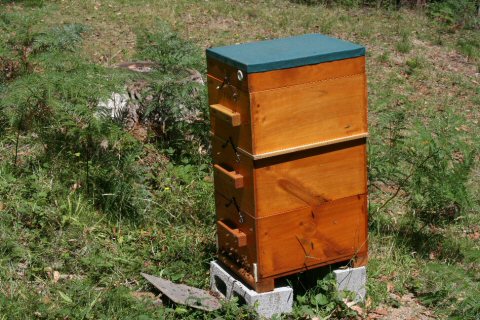Preparing Bees for winter
Bee activities are reducing with falling temperatures.
Varying by subspecies, bees stop flying when the temperature drops below 9°C.
During spring and summer, when the bee population is at its peak and honey is being produced and stored in comb, it is common practise to increase the size of the beehive to cater for the increased demand for space and to reduce the bees' urge to swarm.
Whilst the hive composition of three or four hive boxes, stacked on top of each other, can be optimal for summer conditions, it is not optimal for winter and has to be reduced.
Bees need to prepare for flight
For a Honeybee to be able to fly the body temperature needs to be 35°C. A bee needs to prepare herself for flight by raising the body temperature. Bees achieve this by generating heat with their body, taking in some honey and converting it to energy.
Likewise, a bee colony needs to maintain a constant brood nest temperature of 34°C in winter and 35°C in summer. They achieve this with so called "Heater Bees" who can generate a body temperature of over 43°C with their wing muscles whilst disengaging their wings and pushing their body into so called Heater Cells, i.e. empty cells randomly placed among the brood cells. They also press their immobilised body onto the brood comb for up to 30 minutes, transferring their body heat onto the comb. The energy for heating is obtained from honey.
Honey serves as fuel; pollen provides the proteins bees need in their diet. To survive a lengthy period of time without bringing in fresh nectar and pollen bees rely on their stores of pollen and honey, the only reason they store it - not as a gift for the beekeeper.
Helping a colony of bees to conserve energy and keep the brood nest warm a beekeeper should reduce the size of the hive before winter. Instead of three or four boxes stacked on top of each other to cater for summer conditions, compact the hive to one or two boxes at the most. A small house does not need as much heating as a big house when it is cold.It is of no benefit to the bees to keep a super stacked on the hive filled with frames containing only empty comb or wax foundation. The unoccupied hive volume is subject to the build up of condensation on the internal walls, leading to mould and fungus related issues.How much to compact the hive also depends on the size and the subspecies and characteristics of the bee colony; Italian bees typically maintain a bigger population throughout winter and require more food stores. Caucasian and Carniolan bees shrink their colony to a very small size during winter and don't consume as much food stores as their Italian counterparts.Hence, if at the end of summer you have a strong colony of Italian bees it would be better to compact them into two boxes with plenty of food stores (honey and pollen) rather than squeezing them into one box and let them run out of food in the middle of winter.A colony of Caucasian or Carniolan bees has typically already reduced their population by the end of the season, often retreated to one box (in most cases the lower box) while the other box(es) are sparsely occupied by bees. This being the case, they are best compacted into one box, provided it is ensured that at least 60% of the total comb area is filled with honey plus some pollen, which adds up to 12kg of honey in an 8-frame Langstroth box.If your hive assembly has a queen excluder between the brood box and the super, make sure it does not stay there during winter; place it under the lid or remove it completely. The worker bees might migrate into the box above the queen excluder when food stores are used up in the lower box, leaving the queen, drones and larger worker bees behind in the lower box.Make sure your bees have enough food stores to last them through the winter and spring build up. more about feeding beesIf you are relocating the hives at the end of summer make sure they are placed in a sunny and wind protected loacation, a sun trap.Make sure the hive is tilted towards the front, so water can escape out of the entrance. Condensation builds up inside the hive during cold temperatures and needs to escape.The build up of condensation during cold nights can be reduced by providing better insulation for the lid. The common hive lids don't provide much insulation, if at all. If exchanging the lids with better insulating lids is not an option, placing a second lid or some insulation material onto the existing hive lid does help.Putting a brick or rock onto the lid has the effect of a heat sink and increases the build up of condensation. The brick keeps the lid cold after a cold night.3-tier hive assembly, typical summer configuration.Single-box hive, typical winter configuration.
End of Scenario

